
Best viewed in
Internet Explorer
PDF
Back to

Updated
06/17/2013 |
Celtic Cross
The
Celtic cross is a symbol that combines a cross with a ring surrounding
the intersection. It belongs to a kind of crosses with a nimbus.
The history of this powerful symbol is ambiguous. There are many
variations of interpretations and legends about the original meaning
that are commonly repeated even today. The Presbyterian and Catholic are
often startled to learn that the other considers this symbol their own.
In our modern multicultural world the ringed cross is as much a symbol
of ethnic heritage as it is of faith and it is often used as an emblem
of one’s Irish, Scottish or Welsh identity.
In
Ireland, it is a popular legend that the Celtic Christian cross was
introduced by Saint Patrick when preaching to some soon-to-be converted
heathens was shown a sacred standing stone that was marked with a circle
that was symbolic of the moon goddess. Patrick made the mark of a Latin
cross through the circle and blessed the stone making the first Celtic
Cross. This legend implies that the Saint was willing to make ideas and
practices that were formerly Druid into Christian ideas and practices.
This is consistent with the belief that he converted and ordained many
Druids to lives as Christian priests.
These
and many other stories and beliefs are the sort of folk lore history
that cannot be substantiated by the academic convention of looking back
into the written record for early citations or for iconographic
precedence that contains enough supporting evidence of what the artist
is really trying to say. What we have from the modern scholars and
archeologists about Celtic art from early times are careful descriptions
and comparisons.
The Cross did not become a
common symbol of Christianity until the 4th century. Images of the cross
were in fact quite rare before the Golden Legend became popular
and the "discovery" of the "True Cross" promoted fragments of the "True
Cross" as powerful relics.
|
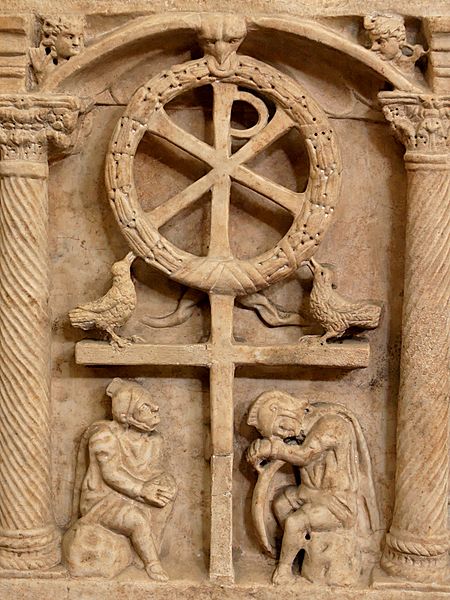 |
The Cross did not become a common symbol of Christianity
until the 4th century. Images of the cross were in fact
quite rare before the Golden Legend became popular
and the "discovery" of the "True Cross" promoted fragments
of the "True Cross" as powerful relics.
There are in
Britain stone monuments that may be the ancestor of the
Celtic Cross. The Chi-Rho symbol, the monogram of
Christ was a commonly used symbol of Christianity in the 4th
century Roman Empire. The Emperor Constantine who made
Christianity the official religion of the Roman Empire used
as his emblem the Chi-Rho in a laurel wreath. Thus
combined was the pagan Imperial symbol of Rome with a symbol
of the new faith. The diagonal cross members of the Chi
were eventually conventionalized to a single horizontal
cross member that made its cross with the vertical stem of
the Rho and the wreath was conventionalized into a
simple circle. There are examples of this where the loop of
the Rho is also conventionalized into a shepherd’s
crook. One can easily see how the curved crook of the staff
could disappear to leave just a cross in a circle as is
common in many Welsh crosses of the early Celtic Christian
period which followed the Roman withdrawal from Britain. |
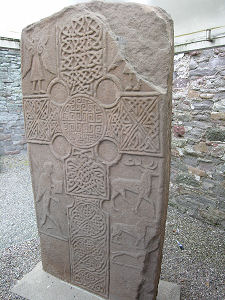
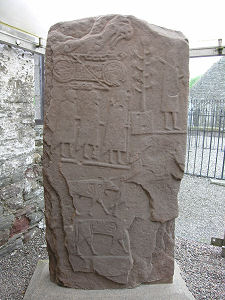 |
The early
circled cross stone monument as it survives in Ireland
and Scotland exists in two forms, the incised slab and
the free standing cross. The slab form has a cross
carved in relief where the free standing cross has the
stone cut away so that the shape of the ringed cross is
carved in the round. In both types there are examples
that range from crude and primitive to the very ornately
decorated. In many cases the most highly decorated have
carving on all the surfaces, even the edges of the ring
and ends of the arms.
The carvings
fall into several categories, with several or all of
these present on any example. Human figures representing
Biblical stories or the crucifixion offer the most
obvious meaning. |
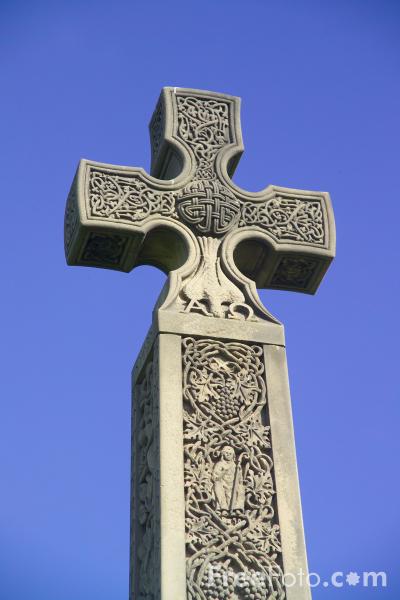 |
Endless
knotwork, spirals, meanders and "key patterns" and
zoomorphic animal patterns make up the majority of
early cross carving subjects.
These
are the same elements that are used in much the same
way in metalwork and in Gospel illumination. The
term insular is used to describe this style.
There are many regional variations. The Iona group
crosses are distinctive in their shape. Many of the
Irish High crosses of the 10th century are capped
with a pitched roof or "house cap" that are similar
to reliquaries made to resemble a Celtic oratory.
On several crosses, notably the Cross of Muiredach
at Monasterboice (shown above) and the Cross of the
Scriptures at Clonmanois, both in Ireland Christ is
enthroned in Glory at the center of the cross.
The
stone monuments can be attributed to specific places
since they rarely were moved more than short
distances. What may have been carved in wood, ivory
or embroidered has been lost to us. Surviving work
from earlier than the 10th century in those
materials are extremely rare. St. Adomnán writing in
the 7th century reports that there were several
hundred wooden crosses on Iona, but none survive
today. |
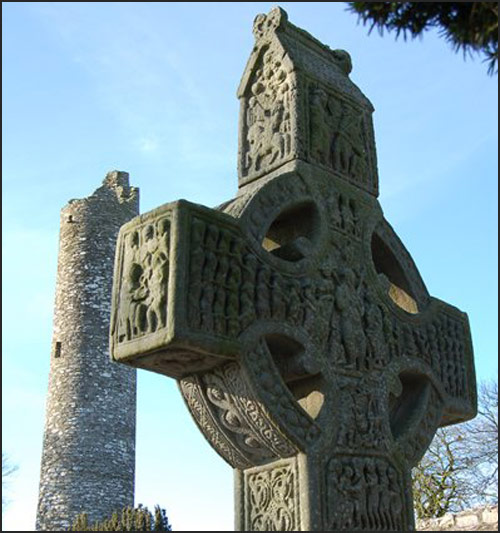 |
|
There are similar crosses in France, which some
specialists think are influenced by those from
Ireland. But the correct expression to define
the continental crosses is "cross with nimbus" (croix
nimbée in French). Their design is
different, but all the French examples are quite
analogous in shape to each other. They are found
mainly in the western part of France, in
Normandy, Britanny and Limousin as far as
Auvergne in the center. Most of them were made
around the 15th century.
In
Galicia Celtic crosses are usually found atop
horreos (granaries) as a protective measure
against any kind of evil. They can
also be found atop churches, and since the
beginning of the 20th century in cemeteries, but
they are unusual in cruceiros (high
crosses). A very characteristic Galician style
combines a Celtic cross with a Celtic
simple knot. It is similar to the St Maur cross
at Glanfeuil Abbey that could have
been made between the 9th and the 11th century.
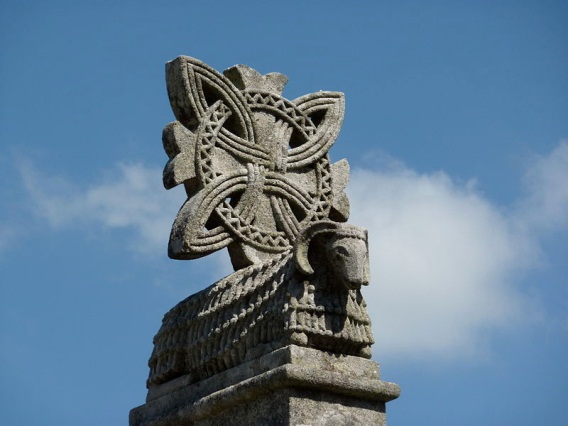 |
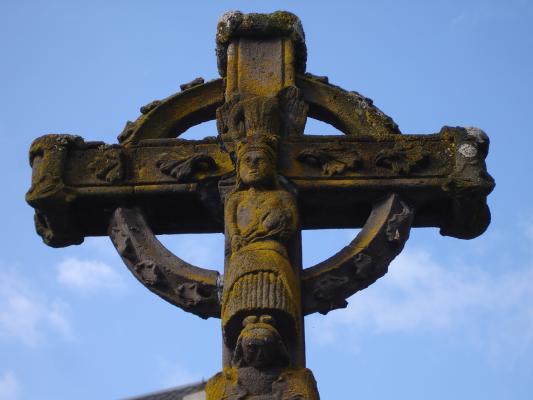 |
The Celtic
Revival of the mid-19th century led to an increased use
and creation of Celtic crosses in Ireland. In 1853 casts
of several historical high crosses were exhibited to
interested crowds at the Dublin Industrial Exhibition.
New versions of the high cross were designed as
fashionable cemetery monuments in Victorian Dublin in
the 1860s. From Dublin the revival spread to the rest of
the country and beyond. Since the Celtic Revival, the
ringed cross became an emblem of Celtic identity, in
addition to its more traditional religious symbolism.
Since its
revival in the 1850s, the Celtic cross has been used
extensively as grave markers. This was a departure from
medieval usage, when the symbol was more typically used
for a public monument. The Celtic cross now appears in
jewelry, T-shirts, tattoos, coffee cups and other retail
items.
|







